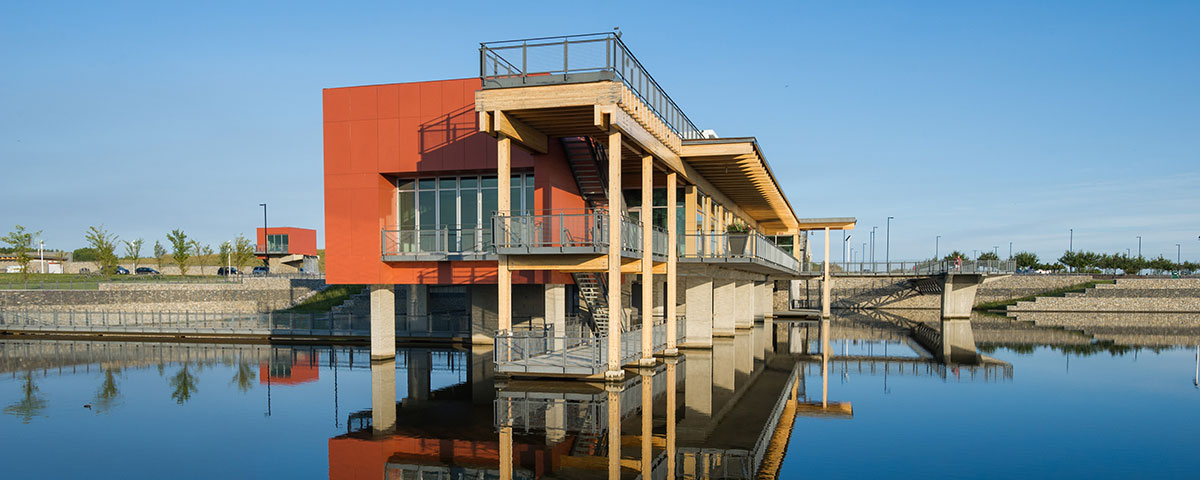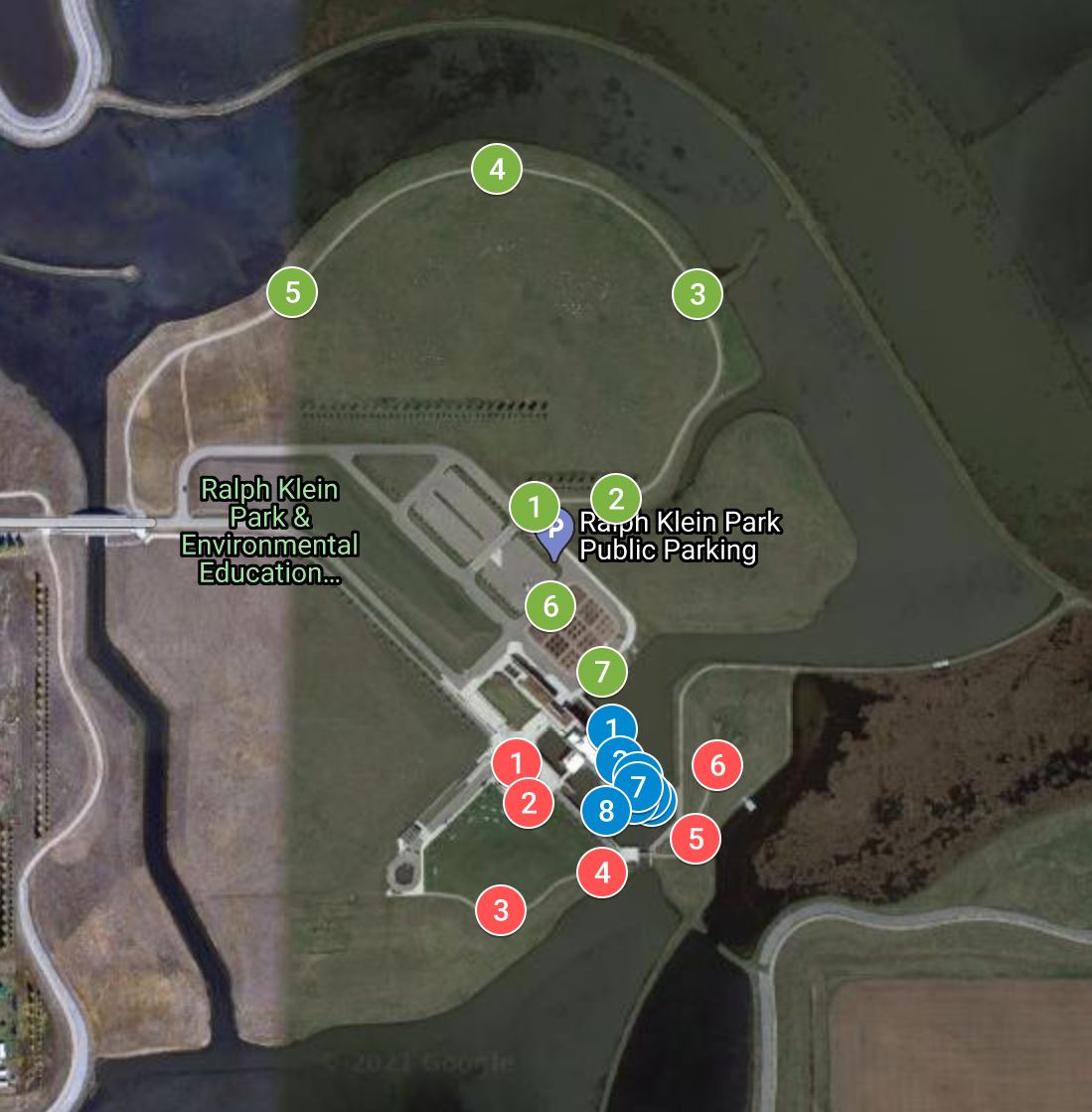Ralph Klein Park self-guided walk
Total distance: Approximately 2.5 km
Start location: Trailhead east of the main parking lot
Difficulty: Flat with some paved sections
Please be respectful of other park users and follow Parks Bylaws:
- Stay on designated trails
- Do not litter
- Do not disturb or feed wildlife, including birds
- Do not collect plant or animal material
Enjoy your walk!
Stop 1: Start
Ralph Klein Park is named after Calgary’s 32nd Mayor and Alberta's 12th Premier. Ralph Klein was a visionary and tireless advocate for Calgary and Alberta. As of 2017, the Environmental Education Centre at Ralph Klein Park is a Leadership in Energy and Environmental Design (LEED) Platinum-certified building. The Shepard Wetland at Ralph Klein Park functions as both a stormwater storage facility and a treatment wetland that naturally filters stormwater before it returns to the Bow River. At 156 hectares (385 acres), it is the largest constructed stormwater treatment wetland in Canada.
Walking directions
Continue down the pathway to the benches.
Stop 2: Wildlife in the park
Many species of birds, mammals, and invertebrates live in the park. You can sometimes even hear coyotes yipping during dawn and dusk as they defend their territory and search for rodents to eat. Two other mammals often spotted in this park are White-Tailed Deer and Mule Deer. Badgers are carnivorous mammals adapted to a digging lifestyle. The large holes found in the grasslands are likely badger dens. During summer, you might see American White Pelicans floating on the water or resting on land. They are one of the world's most giant birds, with a three-meter wingspan. Western Meadowlarks are another summer resident that might be hard to see but not to hear! Look for this brown and white songbird with a bright yellow and black chest.
Walking directions
Continue down the pathway and stop about 300 m before you reach the main road.
Stop 3: Where's the water?
Water enters the wetland at the northwest corner, flowing into two large forebays. Here, the water slows down significantly, allowing sediments and other heavy materials to sink to the bottom. Next, the water enters one of five wetland cells that comprise most of the wetland. In these cells, plants and microorganisms work to remove pollutants, such as excess nutrients, from the water. Did you know aquatic plants have particular adaptations to help clean the wetland? The aquatic plants take up pollutants and transform them into a non-toxic form! This is called phytoremediation. Berms in each cell create a long, maze-like path for the water to flow. The longer the water remains in a cell, the cleaner it will be. Once the water flows through a cell or two, it enters a discharge bay. This empties into a canal that leads to the Bow River, over 10 km away.
Walking directions
Follow the paved pathway across the road back to the main parking lot.
Stop 4: Orchard
This apple orchard is part of the City's Community Orchard Research Project. It contains nine different plots of apple trees and five varieties of pear trees planted along the parking lot. The orchard aims to test a range of fruit trees and shrubs to determine the survival rates and quality of the fruits produced. Furthermore, the orchard educates Calgarians on the benefits of local food production and fosters community involvement. For the orchards to continue bearing fruit in the coming years, they require pollinators.
Unfortunately, native bee populations have declined across the continent due to parasitic mites, habitat loss, and climate change. The City has set up mason bee houses at some orchard sites to increase mason bee colonization and pollination of the orchards.
Walking directions
Walk across the road towards the main entrance of the building.
Stop 5: LEED certification
As of 2017, the Environmental Education Centre at Ralph Klein Park is a Leadership in Energy and Environmental Design (LEED) Platinum-certified building. LEED is a third-party green assessment and certification program for environmentally friendly buildings. Can you see any sustainable designs that would have helped Ralph Klein Park become Platinum-certified?
Notice how the building is oriented northwest to southeast. The overhang on the east-facing window acts like the brim of a hat and shades the glass from direct light during the hottest part of the day. Also, there is LED lighting throughout the building and in the main hall. Further, the windows of this building provide light but also influence heating and cooling. With minimal tint, the windows allow almost 70% of available light to pass through, providing natural light instead of artificial lighting. In comparison, most office buildings downtown only allow 20% of available light to pass through.
Walking directions
Walk across the balcony to the staircase on the south end of the building.
Stop 6: Animal interactions
The man-made wetlands and structures interact with nature every day! Did you know Cliff Swallows nest under the building along the duck walk? These fascinating birds usually make their nests on or near cliffs. Cliff Swallow colonies often use infrastructure such as buildings or bridges, as they are perfect for protecting the nests. Animals such as deer, coyotes, and mice take advantage of the orchard, eating the tasty apples that fall to the ground. Eagles and hawks stand tall on the art piece, searching for prey, while the ground squirrels burrow tunnels underneath the peaked land formations below. We must respect the plants and animals while visiting Ralph Klein Park. Keeping our distance from wildlife and keeping the park clean is important!
Walking directions
Walk up the stairs (or take the elevator inside the building) to get to the next stop on the roof.
Stop 7: A green roof
Unlike cement blocks, the green roof absorbs rainwater, which reduces runoff. The plants provide an excellent space for special events and enhance the views of the surrounding wetland. The cost of heating and cooling of the building is reduced, as the green roof helps regulate building temperature. These plants also provide food and shelter for animals!
Other green features include the solar thermal panels on the north side of the building, which use the sun’s energy for heating. Finally, notice the Glulam beams created by bonding together individual pieces of lumber.
The beams here are considered local, as the wood comes from within an 800 km radius of the park. Steel would likely come from Vancouver, Toronto or even China!
Walking directions
Continue to explore the roof and walk down the stairs to the bottom level of the building.
Stop 8: Duck walk
On the west side of the building, you will see photovoltaic solar panels on a vertical pillar. These panels convert the Sun’s energy directly into electricity, which can power things like parking lot lights and office computers.
The Gabion walls are one of the most striking features of the park and building. It took 18 workers almost 18 months to put all the Gabions together, indoors and outdoors. The Gabions are filled with approximately 498 truckloads of rock!
Did you notice the dark-coloured line on the outdoor Gabion wall? This line indicates the wetland's maximum capacity holding 6,240,000,000 (Six billion, two hundred and forty million) litres of stormwater!
Walking directions
Follow the pathway north, towards the waterfall.
Stop 9: All about stormwater
Water runs off our streets, parking lots, and natural areas when it rains. Unfortunately, many pollutants are often collected along the way. These materials then flow into storm drains, which drain directly into our rivers. Stormwater is not legally required to be treated, so we must do our part to keep our stormwater free of contamination. This constructed wetland functions like a natural wetland, treating stormwater runoff for most of Calgary’s eastern communities before releasing it into the Bow River. Although the wetland is doing its job in cleaning the water, it is still not clean enough to swim in or drink. Therefore, it is important not to touch or play in the wetland, including the waterfall! In the winter, going on the ice is also not permitted. This is because the constant flow of water and contaminants change the ice's structure, making it less stable and prone to breaking when stepped on!
Walking directions
Walk south towards the natural playground.
Stop 10: Natural playground
The natural playground, sponsored by TD Bank, was designed by grade 3, 4, and 5 students from three different elementary schools in Calgary. Students provided feedback on the equipment and features they wanted to see in the new play area. The playground allows for risk-taking, which is an integral part of play! The natural playground design focuses on a watershed theme. It tells how water moves from the mountains down to the wetlands. Each feature demonstrates the connectivity of humans, wildlife, and natural habitats and ties into the key message at Ralph Klein Park: “We all live downstream from someone else.”
Walking directions
Walk across the green field towards the lookout platform.
Stop 11: Marsh monsters
What lies under the surface of the water is a whole new world! This wetland is home to many types of marsh monsters, which play an essential role in the ecosystem. Look carefully. Can you spot these little invertebrates (animals without a backbone) swimming in the water? Aquatic invertebrates often spotted in the water include giant water bugs, leeches, predaceous diving beetles, and snails. Remember, the water all around you is stormwater, and it’s not safe for us to go in.
Walking directions
Follow the pathway towards the art hill.
Stop 12: Art hill
Beverly Pepper, a world-renowned artist, created the Calgary Sentinels and Hawk Hills in 2013. Pepper stated that “the monoliths at Ralph Klein Park are meant to herald the uniqueness of the wetlands” and that her “work offers a place for reflection and contemplative thought within the context of active urban environments.”
If you listen closely on a windy day, you can hear the third, smaller sentinel singing. The monoliths and pyramids are historical markers, designating the wetlands as an essential part of Calgary's legacy.
This is a great space to stop, take a breath and notice what is happening around you. Think about everything you now know about this wetland and how you can help protect our parks in the future.
Walking directions
Continue to explore the art hill, and then, if time allows, revisit your favourite stops.



